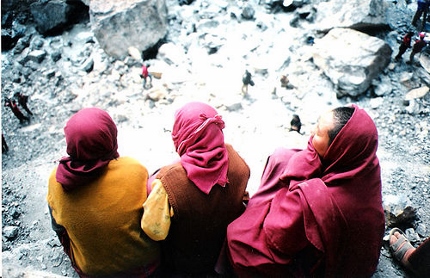India’s leading female mountaineer and economist will set up a network of climbing clubs across the Himalayas to encourage more women to get involved in business and conservation

Women reap little benefit from tourism and the climbing industry in the Himalayas, says Harshwanti Bisht, one of the first woman to summit the main peak of Nanda Devi and a member of the Indian expedition to Mount Everest in 1984. To mark International Women’s Day on the 8 March, she talked to Athar Parvaiz about her new project, which is trying to create opportunities for women in mountainous regions.
Athar Parvaiz (AP): Please introduce your new project Mountain Power?
Harshwanti Bisht (HB): Mountain Power, in collaboration with Nepalese NGO Mountain Legacy, is setting up a network of women’s mountaineering clubs affiliated with colleges and universities throughout the Himalayan region.
Mountain Power clubs will not only provide girls and young women experience in sports such as climbing, trekking, skiing and rafting, but would also foment an interest in conserving nature, protecting cultural sites and developing economic opportunities.
The project aims to build trans-boundary highland-lowland cooperation among women for challenging recreation, responsible tourism, health, entrepreneurial leadership, and sustainable stewardship of the natural and cultural legacy of mountains.
These young climbers will go on to take jobs, launch companies, serve in government agencies and raise families, where they will spread their commitment to mountain recreation, conservation and empowerment of local communities.
Women need the confidence and the skills to become entrepreneurs, leaders and policy makers. As mountaineers, they will combine sports with practical work in recreation planning and economic development. They will undertake projects of their own choosing – be it waste-management, afforestation, trail improvement, infrastructure design or whatever seems useful.
AP: Where did this idea come from?
HB: After working for years in mountains as a climber, researcher and activist, I thought it was time to help women see opportunities in challenges, and to act on them. There are many opportunities for women, but the point is how to find those opportunities and take advantage of them.
I observed that the efforts of women are exploited in every domain. They work day and night in their homes, but hardly spend a single penny according to their wishes. For example, a woman, apart from doing domestic chores such as caring for the children, preparing meals and collecting firewood, also feeds her cow and milks it, but the milk is taken to the market by her husband; he sells it and simply pockets the money.
Also most tourism jobs, such as running travel agencies, serving as guides and managing hotels, are carried out by men. This is because girls get limited education, and have little exposure to the practical logistics of the tourist trade. They forfeit all the rewards of life in one of the world’s great recreational regions – the Himalayas.
AP: You have also done a lot of work in Gangotri region, where Ganga River originates. What inspired you?
HB: When I was in Khumbu with the 1984 Indian Everest Expedition, I saw the great effect of Sir Edmund Hillary’s work to conserve the natural environment and to bring economic opportunities to Sherpa communities.
This inspired me to work in Gangotri. I started restoring the birch forests around the sacred Gau Mukh (Cow Snout), the terminal area of Gangotri glacier, in an attempt to stabilise the receding glaciers. At the same time, I launched an eco-awareness campaign to preserve endangered medicinal herbs, and introduced ecotourism standards to an area that has been ravaged by unregulated tourism.
Harshwanti Bisht has been designated to receive the 2014 Sir Edmund Hillary Mountain Legacy Medal for her conservation work in Gangotri.
